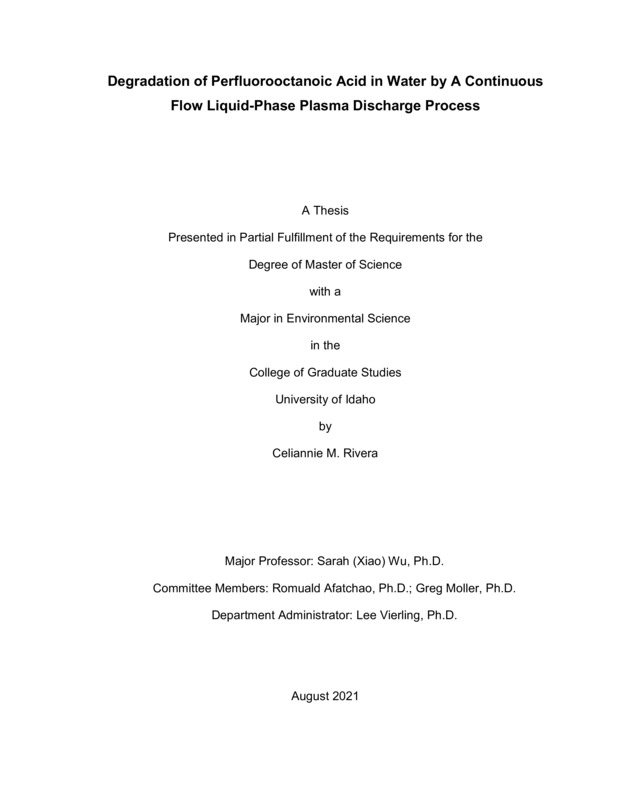Degradation of Perfluorooctanoic Acid in Water by a Continuous Flow Liquid-Phase Plasma Discharge Process
Rivera, Celiannie Mary. (2021-08). Degradation of Perfluorooctanoic Acid in Water by a Continuous Flow Liquid-Phase Plasma Discharge Process. Theses and Dissertations Collection, University of Idaho Library Digital Collections. https://www.lib.uidaho.edu/digital/etd/items/rivera_idaho_0089n_12204.html
- Title:
- Degradation of Perfluorooctanoic Acid in Water by a Continuous Flow Liquid-Phase Plasma Discharge Process
- Author:
- Rivera, Celiannie Mary
- Date:
- 2021-08
- Embargo Remove Date:
- 2022-09-01
- Keywords:
- CFLPPD liquid phase plasma PFAS PFOA Plasma Technology plasma treatment
- Program:
- Environmental Science
- Subject Category:
- Environmental science; Chemical engineering
- Abstract:
-
Perfluorinated Alkyl Substances (PFAS), commonly known as the “forever chemicals.” are comprised of a group of anthropogenic, fluorinated organic compounds that have been used for over 60 years in numerous products, including water-repellent clothing, stain-resistant fabrics, firefighting foams, cosmetics (lipstick and mascara), and other household items. They are highly hydrophobic due to strong carbon-fluorine bonds in their structure. Although no longer produced in the United States, these compounds are ubiquitous in the environment and have been detected in plants, animals, and humans. Source emissions include various manufacturing processes that once discharged their wastes into ground- and surface waters. Many studies have documented that PFAS are found in drinking water and bioaccumulate in the food chain. In the U.S., PFAS have been detected in more than 712 locations in 49 states and Puerto Rico. The same attributes that lead to their persistence in the environment makes their complete destruction difficult. The available remediation technologies used to remove or degrade PFAS in water have limitations, either due to cost or generation of PFAS solid wastes that require disposal. Research shows that plasma discharge processes can break the carbon-fluoride bonds of PFAS, but still do not achieve consistently high levels of removal. In this study, we developed a novel, continuous flow, liquid-phase plasma discharge (CFLPPD) process that shows promise for PFAS remediation. The reactor design generates a stable plasma discharge in a continuous/calculational operation to improve the treatment efficiency by producing reactive chemical species. This research included establishment of the CFLPPD treatment system; identification, screening, and evaluation of the significant operational parameters in order to determine the optimal treatment conditions; and exploration of the degradation pathway of an exemplar PFAS by this novel process.
- Description:
- masters, M.S., Environmental Science -- University of Idaho - College of Graduate Studies, 2021-08
- Major Professor:
- Wu, Sarah
- Committee:
- Moller, Greg; Afatchao, Romuald
- Defense Date:
- 2021-08
- Identifier:
- Rivera_idaho_0089N_12204
- Type:
- Text
- Format Original:
- Format:
- application/pdf
- Rights:
- In Copyright - Educational Use Permitted. For more information, please contact University of Idaho Library Special Collections and Archives Department at libspec@uidaho.edu.
- Standardized Rights:
- http://rightsstatements.org/vocab/InC-EDU/1.0/

